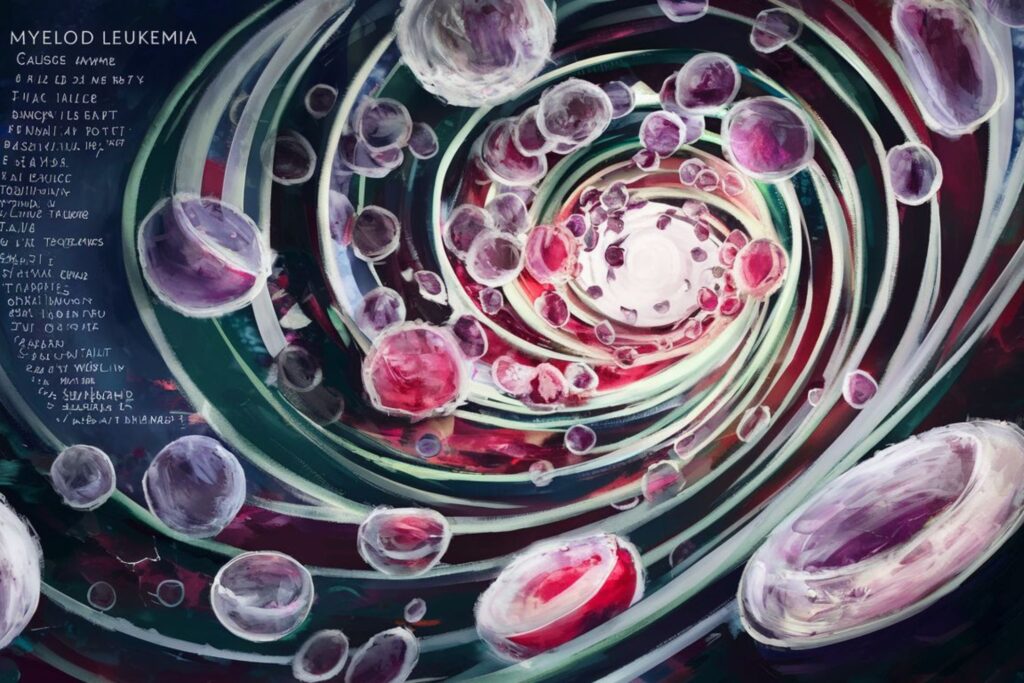The Impact of Myeloid Leukemia on Patients and Families!
Myeloid Leukemia, a type of blood cancer that affects the bone marrow and blood cells. Living with myeloid leukemia can be a challenging journey that not only affects patients but also deeply impacts their families.
From the moment of diagnosis through the treatment journey and beyond, individuals are faced with physical, emotional, financial, and social challenges. This article explores the multifaceted effects of myeloid leukemia on patients and families, delving into the complexities of diagnosis, treatment options, and the long-term implications of this disease.
Additionally, it highlights the crucial role of support systems, coping strategies, and advocacy efforts in navigating the challenges associated with myeloid leukemia.

Table of Contents
ToggleWhat is Myeloid Leukemia?
Myeloid leukemia, also known as myelogenous leukemia, is a type of cancer that affects the bone marrow and blood. This disease is characterized by the rapid growth of abnormal white blood cells, which can crowd out normal blood cells and lead to a variety of symptoms, such as fatigue, weakness, and increased susceptibility to infections.
Myeloid leukemia can be further classified into acute and chronic forms, with acute myeloid leukemia (AML) being the more aggressive and fast-growing type.
The exact cause of myeloid leukemia is not fully understood, but it is believed to be linked to genetic mutations that disrupt the normal production of blood cells in the bone marrow.
Treatment for myeloid leukemia typically involves chemotherapy, radiation therapy, and bone marrow transplants. The prognosis for patients with myeloid leukemia varies depending on the specific type of leukemia, the patient’s age, overall health, and response to treatment.
Research into new therapies and targeted treatments for myeloid leukemia is ongoing, with the goal of improving outcomes and quality of life for patients with this challenging disease.
Read more about “Understanding the Genetic Factors of Myeloid Leukemia and the Emerging Treatments”
The Effects of Myeloid Leukemia on Patients
Patients with myeloid leukemia often experience symptoms such as fatigue, weakness, and frequent infections due to a decrease in healthy white blood cells. In addition, the cancerous white blood cells can crowd out normal cells in the bone marrow, leading to anemia and bleeding problems. These physical symptoms can greatly impact a patient’s quality of life and ability to carry out daily activities.
Furthermore, the emotional and psychological effects of myeloid leukemia can also be significant. Patients may experience feelings of fear, uncertainty, and anxiety about their diagnosis and treatment options.
The financial burden of medical bills and the impact on relationships with loved ones can also contribute to stress and emotional distress. Support from healthcare providers, family, and friends is crucial in helping patients cope with the physical and emotional challenges of living with myeloid leukemia.
Summarizing, myeloid leukemia not only affects the physical health of patients, but also their emotional well-being, underscoring the importance of a holistic approach to care for individuals diagnosed with this type of cancer.
Read more about “What are the Causes and Symptoms of Coronary Artery Disease and How to Treat?”
Types of Myeloid Leukemia
There are several different types of myeloid leukemia, each with its own distinct characteristics and prognosis. The most common types of myeloid leukemia include acute myeloid leukemia (AML) and chronic myeloid leukemia (CML).
AML is a rapidly progressing form of leukemia in which the bone marrow produces too many immature myeloid cells, leading to a decrease in the production of normal blood cells. CML, on the other hand, is a slowly progressing form of leukemia in which the bone marrow produces too many granulocytes, a type of white blood cell.
Both AML and CML can be classified further based on specific genetic mutations present in the leukemia cells, which can help predict how the disease will progress and guide treatment decisions.
Another type of myeloid leukemia is myelodysplastic syndrome (MDS), which is a group of disorders characterized by abnormal development and function of myeloid cells in the bone marrow.
MDS can progress to AML in some cases, making it an important condition to monitor and manage. In addition to AML, CML, and MDS, there are several rare subtypes of myeloid leukemia, such as juvenile myelomonocytic leukemia (JMML) and chronic neutrophilic leukemia (CNL).
Read more about “How to Promote Mental Health in LGBTQIA+ Communities?”
These rare subtypes often have unique clinical features and treatment challenges, requiring specialized care from healthcare providers with expertise in managing these conditions. Overall, understanding the different types of myeloid leukemia is crucial for accurately diagnosing and treating patients with these complex diseases.

Causes and Risk Factors of Myeloid Leukemia
Myeloid leukemia, also known as myelogenous or myelocytic leukemia, is a type of cancer that affects the myeloid cells in the bone marrow. The exact causes of myeloid leukemia are not fully understood, but there are several risk factors that have been identified.
Exposure to certain chemicals such as benzene, smoking, and ionizing radiation increases the risk of developing myeloid leukemia. Additionally, individuals with genetic disorders such as Down syndrome or Fanconi anemia are at a higher risk of developing this type of leukemia. Older age is also a significant risk factor for myeloid leukemia, as the incidence of the disease increases with age.
Other risk factors for myeloid leukemia include a history of certain blood disorders such as polycythemia vera or myelodysplastic syndrome, as well as a family history of leukemia.
Some studies have also suggested that certain dietary factors, such as a diet high in red meat or low in fruits and vegetables, may increase the risk of developing myeloid leukemia.
Overall, the development of myeloid leukemia is likely to be due to a combination of genetic, environmental, and lifestyle factors. Further research is needed to better understand the complex mechanisms underlying this disease and to develop more effective prevention and treatment strategies.
Read more about “The Slow Progression of Atherosclerosis: Recognizing the Warning Signs”
Signs and Symptoms of Myeloid Leukemia
The signs and symptoms of myeloid leukemia can vary depending on the stage of the disease and the individual patient. Common symptoms may include fatigue, weakness, and pale skin due to a decrease in red blood cells.
Patients may also experience frequent infections and fevers due to a decrease in white blood cells, which are responsible for fighting off infections. Additionally, bruising or bleeding easily may occur as a result of a decrease in platelets, which help with blood clotting.
As myeloid leukemia progresses, patients may also experience symptoms such as weight loss, bone pain, and swollen lymph nodes. Some patients may develop a swollen spleen or liver, which can cause abdominal discomfort. In more severe cases, patients may also experience difficulty breathing, chest pain, or neurological symptoms such as headaches, vision changes, or confusion.

It is important for patients to seek medical attention if they experience any of these symptoms, as early detection and treatment can improve outcomes for individuals with myeloid leukemia. Treatment options may include chemotherapy, targeted therapy, radiation therapy, or bone marrow transplant, depending on the specific type and stage of the disease.
Diagnostic Procedures for Myeloid Leukemia
Diagnosing myeloid leukemia typically involves a series of diagnostic procedures to confirm the presence of the disease. One of the most common diagnostic procedures for myeloid leukemia is a blood test, which can reveal abnormal levels of white blood cells and other blood counts indicative of leukemia.
Additionally, a bone marrow biopsy may be performed to collect a sample of bone marrow for examination under a microscope to determine the presence of leukemia cells. Imaging tests, such as CT scans or MRIs, may also be used to assess the extent of the disease and identify any tumors or enlarged lymph nodes.
Once a diagnosis of myeloid leukemia is confirmed, further diagnostic procedures may be necessary to determine the specific subtype of the disease and guide treatment decisions. This may involve genetic testing to identify specific mutations or chromosomal abnormalities that are associated with myeloid leukemia.
Additionally, a lumbar puncture may be performed to assess if the leukemia has spread to the central nervous system. All of these diagnostic procedures are crucial in accurately diagnosing and staging myeloid leukemia, which in turn helps healthcare providers develop an appropriate treatment plan tailored to the individual patient’s needs.
Types of Treatment Modalities for Myeloid Leukemia Patients
There are several treatment modalities available for patients with myeloid leukemia, each with its own benefits and potential side effects. One common treatment option is chemotherapy, which involves the use of powerful drugs to kill cancer cells and prevent their growth.
Chemotherapy can be administered either orally or intravenously and is often given in cycles to allow the body time to recover between treatments.
Another common treatment modality for myeloid leukemia patients is stem cell transplantation. This process includes replacing the patient’s unhealthy bone marrow with healthy stem cells from a donor.
Stem cell transplantation can be an effective treatment option for patients with high-risk or advanced forms of myeloid leukemia, as it can help to restore normal blood cell production and reduce the risk of relapse.
However, stem cell transplantation can also carry significant risks, including infection and graft-versus-host disease. Overall, the choice of treatment modality for myeloid leukemia patients depends on several factors, including the patient’s age, overall health, and the stage of the disease.
A multidisciplinary approach involving oncologists, hematologists, and other healthcare professionals is essential to develop a comprehensive treatment plan tailored to the individual needs of each patient.

Emotional Impact of Myeloid Leukemia on Patients and Families
The emotional impact of myeloid leukemia on patients and their families is profound and multifaceted. Individuals diagnosed with this aggressive form of cancer often experience feelings of fear, anxiety, and uncertainty about the future.
The physical toll of treatment can exacerbate these emotions, leading to depression, isolation, and a sense of helplessness. Additionally, families are also deeply affected by the diagnosis, as they struggle to provide support while coping with their own feelings of grief and distress.
The financial burden of treatment can also strain familial relationships and contribute to stress levels. It is crucial for healthcare professionals to address the emotional needs of both patients and families throughout the treatment process.
Providing access to counseling services, support groups, and resources for managing stress can help alleviate some of the emotional burdens associated with myeloid leukemia.
By recognizing and addressing these emotional challenges, healthcare providers can offer holistic care that supports not only the physical health but also the mental well-being of patients and their loved ones.
Impact of Myeloid Leukemia on Quality of Life and Well-being
Myeloid leukemia can have a significant impact on one’s quality of life and overall well-being. Patients diagnosed with this condition often experience symptoms such as fatigue, weakness, increased risk of infections, and bruising easily due to low levels of healthy blood cells. These physical symptoms can lead to decreased energy levels, difficulty performing daily tasks, and limited mobility.
Additionally, the emotional toll of dealing with a serious illness like myeloid leukemia can also greatly affect a patient’s mental health and well-being. The uncertainties surrounding treatment options, potential side effects of therapy, and fear of disease progression can cause anxiety, depression, and feelings of isolation.
It is essential for healthcare providers to address these physical and emotional aspects of myeloid leukemia in order to improve the overall quality of life and well-being for patients battling this disease.
Financial Burden of Myeloid Leukemia Treatment
The financial burden of treating myeloid leukemia can be overwhelming for many patients and their families. The cost of chemotherapy, radiation therapy, bone marrow transplants, and other treatment options can quickly add up, causing significant financial strain.
In addition to the high cost of treatment, patients may also face additional expenses such as hospital stays, medications, and follow-up care. The financial burden of myeloid leukemia treatment can have a significant impact on a patient’s quality of life and ability to access necessary care.
It is important for patients to explore all available resources for financial assistance and support in order to alleviate some of the financial stress associated with treatment.
Support Systems Available for Patients and Families
Myeloid leukemia patients and their families have access to a variety of support systems to help them cope with the challenges associated with this type of cancer. These support systems often include medical professionals such as oncologists, hematologists, nurses, and social workers who provide guidance, treatment options, and emotional support throughout the patient’s journey.
Additionally, patients and families can benefit from joining support groups or online communities where they can connect with others who are facing similar struggles. These groups offer a sense of belonging, empathy, and information sharing that can be invaluable in navigating the complexities of myeloid leukemia.
Furthermore, organizations like the Leukemia & Lymphoma Society offer resources such as educational materials, financial assistance programs, and local events to further aid patients and families in managing their diagnosis effectively.
Overall, having access to these diverse support systems can greatly improve the quality of life for myeloid leukemia patients and their loved ones during this challenging time.
Coping Mechanisms for Dealing with Myeloid Leukemia Diagnosis
Being diagnosed with myeloid leukemia can be overwhelming and frightening, but there are coping mechanisms to help navigate this difficult time. First, it is important to seek support from loved ones, friends, and healthcare professionals. They can provide emotional support and guidance throughout the treatment process.
Additionally, joining a support group for individuals with myeloid leukemia can offer a sense of community and understanding. It is also crucial to take care of your physical and mental health by maintaining a healthy lifestyle through regular exercise, nutritious diet, and adequate rest.
Engaging in stress-reducing activities such as mindfulness meditation or yoga can help manage anxiety and improve overall well-being.
Finally, staying informed about the disease, treatment options, and potential side effects can empower you to make informed decisions about your care. Remember that you are not alone in this journey, and there are resources available to help you cope with your diagnosis.
Long-term Effects of Myeloid Leukemia on Survivors
Survivors of myeloid leukemia may face a number of long-term effects following their treatment. These effects can vary depending on factors such as the individual’s age, overall health, and the specific treatments they received.
Common long-term effects may include fatigue, increased risk of infections, long-term complications related to chemotherapy or radiation therapy, and emotional or psychological challenges such as anxiety or depression.
Additionally, survivors may also face an increased risk of developing secondary cancers later in life, due to the harsh nature of the treatments used to combat the leukemia.
It is crucial for survivors to work closely with healthcare providers to monitor their health and address any lingering effects of their leukemia treatment to ensure they receive appropriate care and support in the long term.
Advocacy Efforts for Research and Awareness of Myeloid Leukemia
Advocacy efforts for research and awareness of myeloid leukemia are crucial in advancing understanding, treatment options, and support systems for individuals affected by this devastating disease.
Organizations such as the Leukemia & Lymphoma Society and the Myeloid Leukemia Foundation work tirelessly to raise funds for research initiatives, provide educational resources for patients and their families, and advocate for policies that prioritize access to quality care.
These advocacy efforts not only help advance scientific knowledge about myeloid leukemia but also play a vital role in promoting early detection, improving patient outcomes, and enhancing overall quality of life.
By raising public awareness, fostering collaboration among researchers and healthcare professionals, and influencing policy changes at local, national, and global levels, advocacy efforts are instrumental in driving progress towards eradicating myeloid leukemia as a significant health threat.
Conclusion:
In conclusion, the impact of Myeloid Leukemia reaches far beyond the physical manifestations of the disease, affecting the emotional well-being and daily lives of both patients and their loved ones. By shedding light on the challenges faced and the support systems available, we can work towards enhancing the quality of care and resilience in the face of this condition.
Moving forward, continued research and advancements in treatment hold promise for improving outcomes and fostering hope for those affected by Myeloid Leukemia.
FREQUENTLY ASKED QUESTIONS
1. How does myeloid leukemia impact a patient’s daily life?
Physical symptoms of the disease, such as fatigue, weakness, and susceptibility to infections, can make it difficult for patients to maintain their usual routines and engage in activities they once enjoyed. Treatment for myeloid leukemia, which often involves chemotherapy, radiation therapy, and stem cell transplantation, can also be extremely taxing on the body and cause side effects like nausea, hair loss, and anemia.
Additionally, the emotional toll of living with a life-threatening illness can lead to feelings of anxiety, depression, and isolation. Patients may also experience financial strain due to medical expenses and time off work for treatment. Overall, myeloid leukemia can significantly decrease a patient’s quality of life and require them to adapt to a new normal of managing their health challenges on a daily basis.
2. What are some common coping strategies for families dealing with a loved one’s myeloid leukemia diagnosis?
Families dealing with a loved one’s myeloid leukemia diagnosis often employ several coping strategies to navigate the challenges associated with the illness. Firstly, seeking support from healthcare professionals, such as hematologists and oncologists, can provide families with vital information about treatment options and care management. Additionally, connecting with support groups or online communities allows families to share experiences and gain emotional support from others facing similar circumstances.
Maintaining open communication within the family unit is crucial for providing comfort and understanding during this difficult time. Furthermore, establishing a routine that includes self-care activities, such as exercise and adequate rest, can help alleviate stress and promote overall wellbeing for all members of the family. By utilizing these coping strategies, families can navigate the complexities of myeloid leukemia together with resilience and strength.
3. Are there support groups available for both patients and families affected by myeloid leukemia?
Yes, there are a variety of support groups available for both patients and families affected by myeloid leukemia. These groups provide emotional support, practical advice, and the opportunity to connect with others going through similar experiences. One well-known organization that offers support for myeloid leukemia is the Leukemia & Lymphoma Society (LLS), which provides resources such as online chats, local support groups, and one-on-one peer support.
Additionally, many hospitals and cancer centers also offer support groups specifically for those dealing with myeloid leukemia. These groups can be a valuable source of information and encouragement during treatment and recovery. It is important for individuals affected by myeloid leukemia to seek out these support groups in order to navigate their journey with a strong network of understanding individuals by their side.





